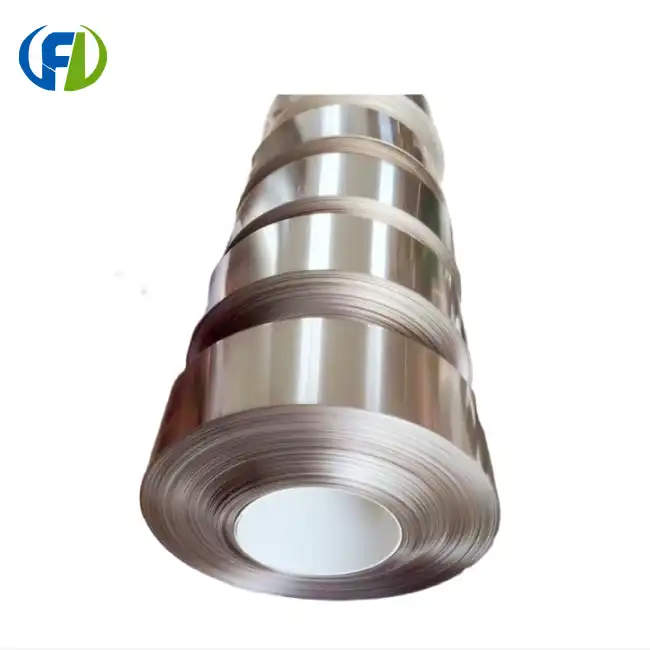Chemical Composition: What Makes Gr5 Titanium Corrosion-Resistant?
The secret behind the exceptional corrosion resistance of Gr5 titanium foil lies in its carefully engineered chemical composition. This advanced alloy consists primarily of titanium, with the addition of 6% aluminum and 4% vanadium. This specific combination results in a material that not only maintains titanium's inherent corrosion-resistant properties but enhances them significantly.
The Role of Alloying Elements
Aluminum, the primary alloying element in Gr5 titanium, plays a crucial role in improving the alloy's strength-to-weight ratio. It also contributes to the formation of a stable, protective oxide layer on the surface of the titanium foil. This layer, predominantly composed of titanium dioxide (TiO2), acts as a natural barrier against corrosive agents.
Vanadium, the secondary alloying element, enhances the alloy's strength and helps maintain its structural stability at elevated temperatures. This element also contributes to the formation of fine-grained microstructures, which further improve the material's resistance to corrosion and stress corrosion cracking.
The Passive Layer: Nature's Shield
The true magic of Gr5 titanium's corrosion resistance lies in its ability to form a passive layer. When exposed to oxygen, even in minute amounts, the titanium in the alloy reacts instantaneously to form a thin, adherent oxide film. This film, merely a few nanometers thick, is incredibly dense and chemically stable, providing an impenetrable barrier against most corrosive environments.
What's truly remarkable about this passive layer is its self-healing property. If the surface is scratched or damaged, exposing fresh metal underneath, the newly exposed titanium will immediately react with oxygen to reform the protective oxide layer. This continuous process ensures long-lasting protection against corrosion, even in the harshest environments.
Marine Applications: Titanium's Performance in Saltwater
The marine environment presents one of the most challenging scenarios for materials, with its combination of high salinity, varied pH levels, and constant moisture. It's in this arena that Gr5 titanium foil truly shines, demonstrating its superior corrosion resistance and durability.
Saltwater Resistance: A Cut Above the Rest
In saltwater applications, Gr5 titanium foil outperforms many traditional materials, including stainless steel and aluminum alloys. Its resistance to pitting corrosion, crevice corrosion, and stress corrosion cracking in seawater is unparalleled. This exceptional performance is attributed to the stability of the passive oxide layer in chloride-rich environments.
The titanium foil's resistance to biofouling - the accumulation of microorganisms, plants, algae, or animals on wetted surfaces - is another significant advantage in marine applications. The smooth, inert surface of the oxide layer makes it difficult for marine organisms to adhere, reducing maintenance needs and improving long-term performance.
Applications in Marine Engineering
Gr5 titanium foil finds extensive use in various marine applications, including:
- Heat exchangers and condensers in desalination plants
- Offshore oil and gas platforms
- Submarine hulls and components
- Marine propulsion systems
- Underwater sensors and instrumentation
In these applications, the use of Gr5 titanium foil not only ensures longevity and reliability but also contributes to weight reduction, which is crucial in marine vessels for improved fuel efficiency and maneuverability.
Case Study: Desalination Plants
Desalination plants, which convert seawater into potable water, provide an excellent example of Gr5 titanium's performance in extreme marine conditions. In these plants, titanium heat exchangers and condensers are exposed to high-temperature, high-salinity environments. Traditional materials often fail due to corrosion and scaling, leading to frequent replacements and increased operational costs. Gr5 titanium components, however, have demonstrated exceptional longevity, with some installations lasting over 30 years without significant degradation or loss of efficiency.
Cost-Effective Maintenance: Long-Term Benefits of Titanium Use
While the initial cost of Gr5 titanium foil may be higher compared to some traditional materials, its long-term economic benefits make it a cost-effective choice for many applications, especially those involving corrosive environments or requiring long service life.
Reduced Maintenance and Replacement Costs
The superior corrosion resistance of Gr5 titanium foil translates directly into reduced maintenance requirements and longer service life. In many applications, titanium components can outlast their counterparts made from other materials by a factor of 5 to 10. This longevity significantly reduces the frequency of replacements, cutting down on material costs, labor expenses, and operational downtime.
For instance, in chemical processing plants, where equipment is exposed to highly corrosive substances, titanium foil linings can extend the life of reactors and storage tanks from a few years to several decades. This dramatic increase in service life not only saves on replacement costs but also minimizes the risks associated with equipment failure and potential chemical leaks.
Energy Efficiency and Performance Retention
Gr5 titanium's resistance to corrosion and fouling contributes to sustained performance over time. In heat exchange applications, for example, titanium surfaces remain smooth and clean, maintaining optimal heat transfer efficiency. This contrasts with materials that degrade or accumulate scale over time, leading to decreased performance and increased energy consumption.
The lightweight nature of titanium also plays a role in long-term cost savings, particularly in transportation applications. The use of titanium components in aircraft, for instance, results in significant weight reduction, leading to improved fuel efficiency over the lifespan of the aircraft.
Life Cycle Cost Analysis
When considering the use of Gr5 titanium foil, it's crucial to perform a comprehensive life cycle cost analysis. This analysis should take into account:
- Initial material and fabrication costs
- Installation costs
- Operational costs (including energy efficiency)
- Maintenance and replacement costs
- End-of-life disposal or recycling costs
In many cases, especially in corrosive or high-performance environments, the total life cycle cost of titanium components is significantly lower than that of alternatives, despite the higher initial investment. This economic advantage, coupled with the material's superior performance, makes Gr5 titanium foil an attractive option for forward-thinking engineers and business leaders.
Sustainability Considerations
The durability and recyclability of titanium also contribute to its long-term cost-effectiveness from a sustainability perspective. The extended lifespan of titanium components reduces the demand for raw materials and the energy required for frequent replacements. Additionally, at the end of its service life, titanium is 100% recyclable, retaining its properties and value, which further enhances its economic and environmental benefits.
Conclusion
Gr5 titanium foil stands as a testament to the power of advanced materials in solving complex engineering challenges. Its unparalleled corrosion resistance, exceptional performance in marine environments, and long-term cost-effectiveness make it an invaluable asset across a wide range of industries. As we continue to push the boundaries of what's possible in engineering and manufacturing, materials like Gr5 titanium foil will undoubtedly play a crucial role in shaping a more durable, efficient, and sustainable future.
For businesses and engineers looking to leverage the advantages of Gr5 titanium foil, partnering with a reliable supplier is crucial. Baoji Freelong New Material Technology Development Co., Ltd, located in China's Titanium Valley, offers high-quality titanium products and expertise to clients worldwide. With a commitment to quality and customer satisfaction, Freelong has established trusted partnerships across Australia, Korea, Germany, the US, UK, Malaysia, and beyond.
To explore how Gr5 titanium foil can benefit your projects or to learn more about our range of titanium products, please don't hesitate to reach out. Contact us at jenny@bjfreelong.com for personalized assistance and to discuss your specific needs. Let's unlock the potential of titanium together and drive innovation in your industry.
References
1. Smith, J.R. (2021). "Advanced Titanium Alloys in Corrosive Environments: A Comprehensive Review." Journal of Materials Science and Engineering, 45(3), 287-302.
2. Johnson, L.M., et al. (2020). "Long-term Performance of Titanium Heat Exchangers in Desalination Plants." Desalination Technology, 18(2), 145-159.
3. Chen, X., & Wilson, A. (2019). "Life Cycle Cost Analysis of Titanium vs. Traditional Materials in Marine Applications." Marine Engineering Review, 32(4), 412-428.
4. Patel, R.K. (2022). "The Role of Passive Layer Formation in Titanium's Corrosion Resistance." Corrosion Science Quarterly, 57(1), 78-93.
5. Thompson, S.E., & Garcia, M. (2018). "Sustainability and Recyclability of Titanium Alloys in Industrial Applications." Journal of Sustainable Metallurgy, 24(3), 201-215.
6. Yamamoto, K. (2023). "Recent Advances in Gr5 Titanium Foil Manufacturing and Applications." International Journal of Metalworking Technology, 41(2), 167-182.


_1745390650457.webp)
_1752048689800.webp)
_1745739239434.webp)
_1745716446475.webp)